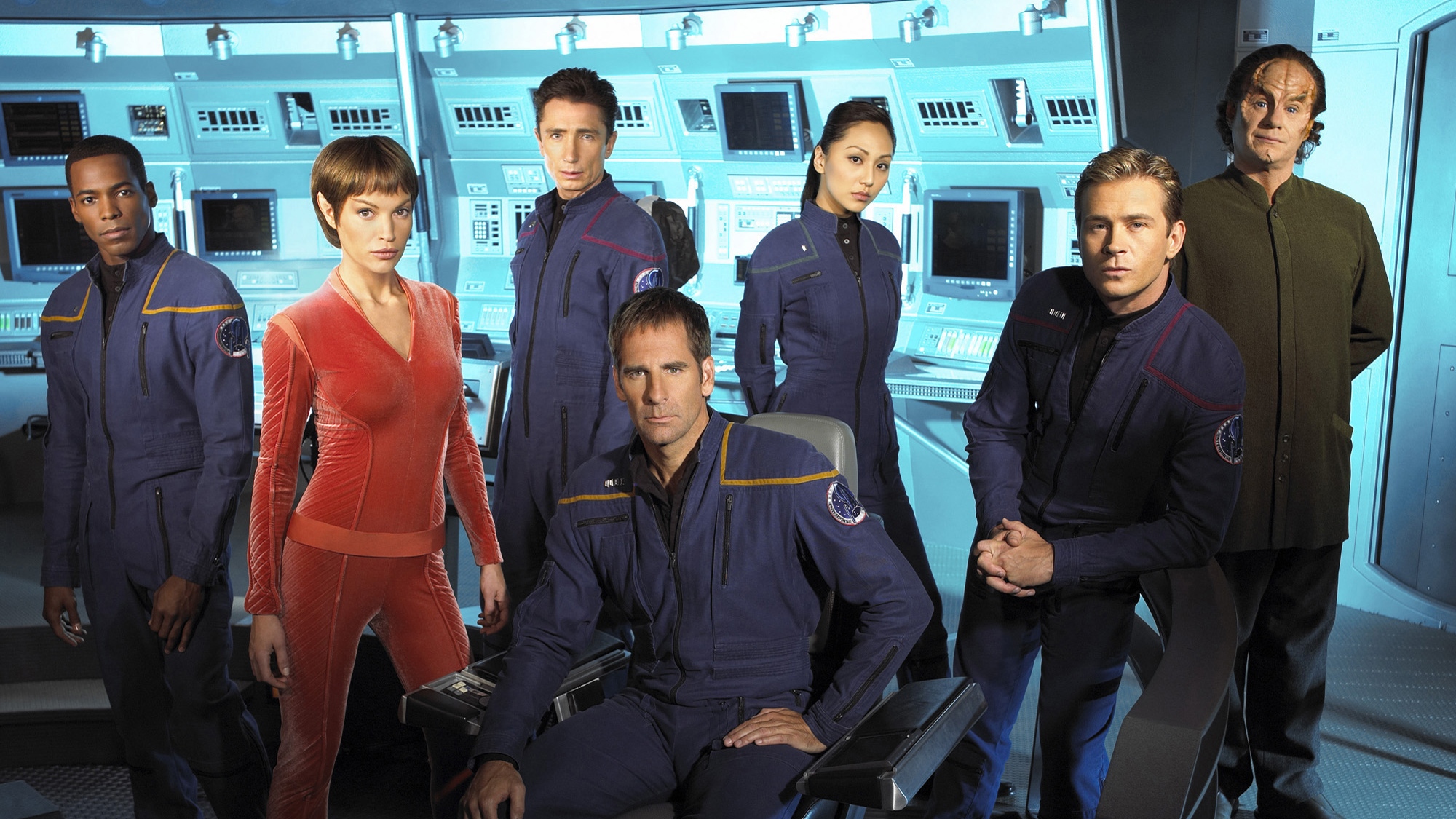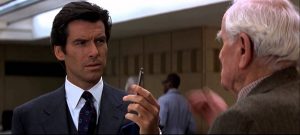
For Star Trek fans, the 1990s lasted 18 years. From 1987 to 2005, there were four back-to-back Star Trek series, which shared common themes, musical styles, and an overall philosophy that feels like what we think of when we think of ’90s sci-fi TV. Although the reboot Battlestar Galactica began its first proper season on Oct. 18, 2004, it’s hard to believe that just three days prior, on Oct. 15, Star Trek: Enterprise aired “Storm Front, Part II,” the conclusion of its season 4 premiere. Enterprise is perhaps the most underappreciated of the Star Trek shows from this period, and maybe that’s because it was a double-throwback. Not only was the show attempting to be a prequel to The Original Series, but, by 2004, it still looked like it could have been made in 1994.
All of this is to the show’s credit, and strangely, because the production values of Enterprise feel fixed in the mid-’90s rather than the early aughts, the series has aged better than perhaps many remember. The two-parter “Storm Front” rarely makes it into anyone’s “best of” Trek lists, and that’s partly because as an epic time travel two-parter, it feels somewhat safe. But that memory is misleading. Rewatching “Storm Front” today is a rowdy viewing experience. Not only does this episode have vintage TNG vibes, but it also sports several canonical assertions that should have upended everyone’s conception of the Star Trek timeline. So, 20 years later, here’s the question: is this the moment Star Trek quietly rebooted?
Star Trek’s Constant Time-traveling
Although space travel is the primary subject of all facets of Star Trek, the most beloved installments of the franchise are very, very often about time travel. Even in the show’s first pilot episode “The Cage,” Captain Pike (Jeffrey Hunter) referred to “time warp” factors when talking about the way the Enterprise traveled through the galaxy. These days, when it comes to time problems and faster-than-light travel, the Trek franchise has created a few in-universe fixes for problems with general relativity and warp drive. But, that doesn’t mean other forms of time travel aren’t a huge headache in the Final Frontier.
Starting with season 1, Enterprise centered time travel into the very fabric of its existence. With the introduction of the Suliban and crewman Daniels (Matt Winston), we quickly learned that a Temporal Cold War was being waged across time, and several factions were vying to alter key points in history. The early days in Starfleet, in the 2150s, were just one of those fronts. Though the show never outright admitted this, the very existence of the Temporal Cold War, in theory, gave Enterprise an automatic pass when it came to canon inconsistencies. Not every battle between Captain Archer (Scott Bakula) and the Suliban—or the Sphere Builders, or the Xindi—dealt with time travel, but the Temporal Cold War was the underpinning to a lot of it. By the end of “Storm Front Part II,” any and all time travel shenanigans were taken out of the Enterprise equation permanently. But not before the show delivered the most on-the-nose time travel battle ever.
“Storm Front” Ended the Temporal Cold War—But Left Several Questions
After dancing around the ideas of changed histories, “Storm Front” went into gonzo alternate history mode. The Enterprise arrives mysteriously in 1944 and finds that parts of the American East have been occupied by Nazi Germany. In this timeline, the Nazis have been aided by an alien race called Na’kuhl, though in both episodes this species name is never spoken aloud. (It’s kind of like the word “Ewok.” Nobody says it out loud in Return of the Jedi, but you know what they are.) The Na’kuhl are led by Vosk, whose name is spoken in both episodes, frequently. Thanks to the arrival of an ailing Daniels—a time agent from the future—the crew of the Enterprise learns that Vosk leads the most dangerous faction in the Temporal Cold War. Daniels also reveals the war has become “…an all-out conflict. Temporal agents, dozens of them stationed throughout the timeline…They’ve been given orders to change history.”
The idea that there are other parallel time wars being fought while we’re watching everything play out in “Storm Front” is fascinating. The viewer has to assume that various other strange realities have been created in both Star Trek history and real history, which we just never see because we’re stuck with the POV of the crew of the NX-01 and their particular front in the Temporal Wars. Daniels says, “Different incursions are causing paradoxes…” but never has time to specify what that means. But, we can imagine quite a bit.
For one thing, the series Enterprise exists in the timeline that was created post-First Contact, in which the USS Enterprise-E traveled back in time from 2373 to 2063. In that film, we’re briefly presented with three possible timelines: “the original” timeline, the timeline that results in an All-Borg populated Earth, and the “fixed” timeline in which Riker and Geordi rode shotgun with Zefram Cochrane, and essentially boot-strapped their own future. Because Enterprise makes direct references to First Contact in its very first episode and in the season 2 Borg episode, “Regeneration,” one could argue that this series began in the altered chronology Picard and the crew haphazardly created. It could also be argued that foundationally, much of Star Trek’s “Prime Universe” has been subtly changed ever since. How many little butterfly effects could possibly be accounted for with all the time travel in First Contact and Enterprise? Uniform changes? Khan’s birth?
But what Daniels tells Archer in “Storm Front Part I,” and what he suggests at the end of “Part II,” is that everything is back to normal. But what’s normal? And was he right?
The Legacy of Star Trek’s Time War
When the NX-01 swoops into 1944 New York City, Archer and the crew find the location of Vosk’s time conduit to the future, lob a few photonic torpedoes, and prevent the Na’kuhl from gaining dominance over the timeline. Daniels appears, restored and young again, and tells Archer, “The timeline’s resetting itself. You did it. Vosk is dead. He didn’t make it back. All of the damage he caused, it never happened.”
That said, Archer and the crew’s memory of these events has not been erased, and Daniels doesn’t say, “All the time travel from this show and all those changes have now never happened.” Daniels also refers to the timeline, which accidentally implies that the Temporal Agents have a preferred version of history, not unlike the MCU’s Sacred Timeline. This idea exists well into the final three seasons of Star Trek: Discovery, in which Kovich (David Cronenberg) explains that by the 32nd Century, the “ironclad” Temporal Accords made time travel illegal. By the series finale of Discovery, we learn that Kovich is really a future version of crewman Daniels from Enterprise, implying that since the end of “Storm Front Part II,” he’s been watching over a version of the Star Trek timeline.
But, as fans know all too well, there is no one set version of the Star Trek timeline. And as much as Kovich/Daniels may have prevented any new time wars post-32nd century, the nature of time travel creates tricky cause-and-effect issues. In Strange New Worlds season 2 episode “Tomorrow and Tomorrow and Tomorrow,” it’s made clear that at least one temporal war is still raging. With the help of an alternate universe Captain Kirk (Paul Wesley), La’an (Christina Chong) learns that Romulans are trying to change history in the year 2022.
In a sense, Enterprise allowed this to happen. When Daniels told Archer that there were dozens of fronts in the Temporal War, one of those could include what we’ve seen recently in Strange New Worlds. In fact, as undercover Romulan agent Sera (Adelaide Kane) reveals: “So many people have tried to influence these events…delay or stop them…it’s almost as if time itself is pushing back and events reinsert themselves. All of this was supposed to happen back in 1992…”
In other words, the current “Prime” Star Trek timeline is different than the way it was during the time of The Original Series or even the classic films. In Strange New Worlds, La’an is an unwitting Time Agent, just like Archer was in Enterprise. But because of the timey wimey-ness of the Temporal Cold War, it’s easy to imagine that all of this is happening at the exact same time. This means that even though Enterprise ended the temporal wars 20 years ago, for modern Star Trek, those conflicts are still very much alive.
The post The Star Trek Enterprise Time Travel Episode That Fixed the First Time War—Or Did It? appeared first on Den of Geek.



